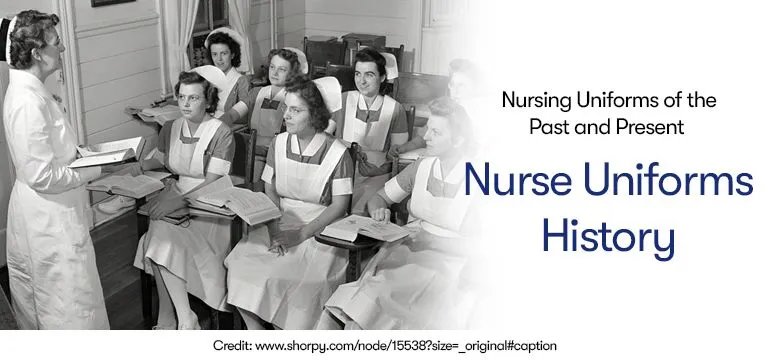
Nursing for the sick was a family obligation back then, so nurses were but family members. In some cases, though, where the sick has no family or is a settler from another land, a self-appointed nurse will attend to his medical, physical and emotional needs. In both circumstances, clothing designed for sanitary purposes is the last thing that would come to mind. And in more organized nursing care facilities, which were basically monasteries and nuns were the nurses, the nursing uniforms were but their habits. A photo below features a 13th century nursing sister, wearing her traditional nun's dress in 1256. No wonder why in the emergence of the first nursing uniform, when nursing profession was already established, it looked like nun's habit. It was like the trained nurses were adopting the rank of a sister.
A picture of a 16th century nurse, illustrated by Warja Honegger-Lavater, is featured below. This rendering was a replica taken from Rome's Institute of Medical History. Such was very close to the dress normally worn by the first modern day nurses, in Florence Nightingale's time. It shows the familiar ankle-length dress, apron, and head covering.
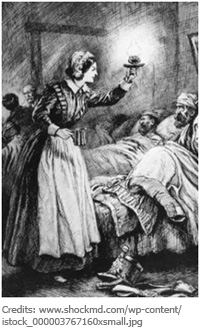
When Florence Nightingale integrated the practices for modern nursing in military hospitals during the Crimean war, which broke in 1854, there were neither appropriate nor inappropriate clothes for nurses. Although, having the communicable diseases avoided by the care givers was of primary concern. In this image, depicting the famous Lady with the Lamp, Nightingale is simply wearing an apron tied to her waist. And of course, we can't expect to have her dress be made out of something with antibacterial properties. Even if she made major revamp of the sanitary conditions in the military hospitals, fabric technology still needs immense improvements during her time.
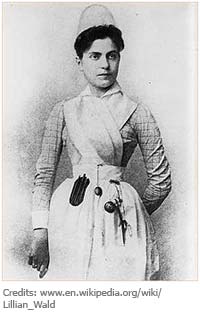
In the following picture is Lillian Wald, a German-Jewish nurse in Cincinnati, Ohio, who started her nursing career on 1893. Notice that young Wald is not wearing a plain white or colored nurse uniform, but a checkered dress with collar. It only indicates that during that time, a period also lived by Nightingale, strict policies about nursing uniform have not yet been implemented, except for the apron. A nurse cap to hold nurses' hair also appeared during this period. In Wald's nursing uniform instruments necessary for nursing patients are attached for easy reach. Perhaps pockets were not yet integrated in nursing uniforms back then.

Crisscross aprons were not forgotten in America's nursing uniforms, in later years, wherein sleeves were cut short already, there are still aprons that make use of the crisscross design that's similar to the one worn by Lillian Wald. However, the latter aprons have their crisscross at the back portion.
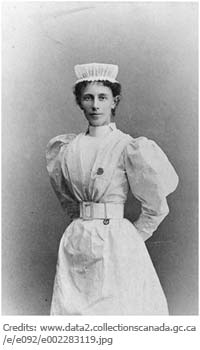
First head nurse of Canadian Contingent to Boer War Georgina Pope wears possibly her nurse uniform from Bellevue Hospital, New York, on 1898. Perhaps, puff sleeve nursing uniforms fashion among American nurses, rooted at the time. It would become popular in the early 1900s in the U.S., and then influence the sleeve designs of nursing uniforms worn by nurses in London, England. You will also notice the use of wide belt that Ms. Pope is wearing in this photo; it's worn both for practical and decorative purposes.
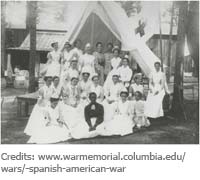
After the creation of first design of nursing uniforms, an accomplishment of one of Florence Nightingale's students, nurses uniforms barely changed. Bibs, which were attached to the pinafores, were the ones that occasionally received changes, along with the caps. Only after the 1940s did the nursing uniforms got major changes. The nurses that served during the Spanish-American War, still wears the uniforms that resemble the first ones. Pictured in the following photo are the nurses of the Red Cross Auxiliary No. E, Sternberg Field Hospital Georgia, in 1898.
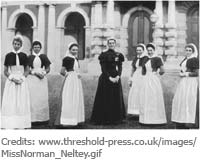
British nurses were able to work for the Up-Country Nurses' Association in India under the Colonial Nursing Association, and practice as private nurses in other colonies from 1883 to 1902. Their short capes easily identify them as travel nurses. Australian travel nurses also used the same design of cape in WWI. As noticed in the picture, the color of the nursing uniforms also played a major role in recognizing ranks. Chief nurses or matrons wore one with darker color, while others have lighter uniforms that go with aprons. Detachable high collars were also used by British nurses during this time.
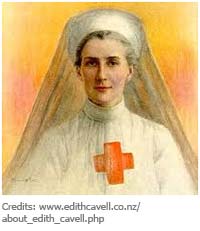
In the early 1900s, nurses such as Edith Cavell wear nursing uniforms similar to that of nuns' habit, with matching nuns' veil. But contrary to common knowledge that nurses simply adopted �sisterhood�, nun's veil was used for sanitary purposes. Hair covering protected wearer's long hair, pulled tightly into a high knot and hidden under the veil or nurse cap, avoiding dangling hair from catching unwanted pathogens. In the portraits depicting Nurse Cavell's execution, she usually lies dead on the ground still wearing a nursing uniform similar to the mentioned. A clearer depiction of Nurse Cavell in the said veil is featured in the image below.

Nursing schools run by religious organizations have often adapted similar design, with major change at the neckline. Instead of featuring a neckline that covers the neck, such as the turtleneck design, there are nursing schools in early 20th century that integrated open neck collars for women. They usually used white fabric for the nursing uniforms, and decorated them with Red Cross emblem on the chest of the habit, at the nursing cap, and with one of the sleeves. When other colors are used for the nursing uniform, the Red Cross emblem is often not used. It's not only the neckline that received alterations, the length of the nursing uniform also changed from full length to just about the mid of the calves.
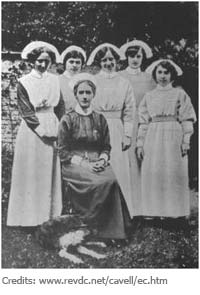
Still during Edith Cavell's time in the nursing industry, a notable aspect of nursing uniforms of nurses and student nurses was the apron worn over their dress. Aprons have almost the same length as their dresses, falling down the ankles. Their primary use was to keep pathogens as far off from the nurses' skin. Secondly, aprons were there to save their dress uniforms from stains. Notice also the cuffs of their sleeves, whether they were intended to keep the wearer warm, protect the arms from the harms of whatever they handle or free the hands from dangling sleeve hem, we do not know. But they worked on all three ways.
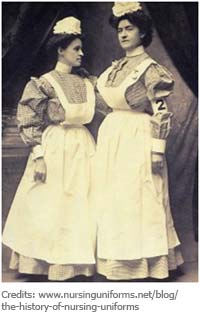
During the 1900s, the nursing uniforms looked like servants uniforms due to the aprons worn over the dress. And with some designs of nurse caps, the servant look became more apparent. Other designs have significantly helped to differentiate servants from nurses, though. Further, the arm band they wear signifies their profession, particularly allowing distinguishing ranks among them. New nurses will have to wear pastel colors, whereas seniors wear black.
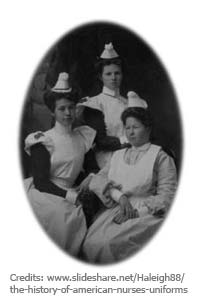
In 1906, nursing uniforms in America didn't always look like servant's uniform. Stylish puff sleeves at the shoulder and tightly fitted sleeves in contrast color balanced with the overly powerful white stiff pinafore. Dresses were still floor-length, with necklines covering the entire neck. The pinafores worn over them were only several inches shorter. And the frilly nurse caps were elaborate.
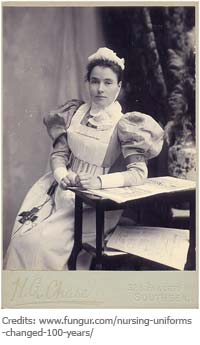
The following photo of a nursing uniform has resemblance with the 1906 and 1936 nursing uniforms. The wearer accessorizes her uniform with fashion cap and arm band. Notice the belt that securely holds her dress and pinafore; it was used to also hold some of the basic medical instruments like the scissors.
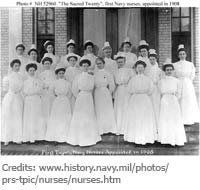
In their photo at the Naval Hospital, Washington, D.C., on October 1908, The Sacred Twenty who were appointed in 1908 as U.S. Navy nurses, wore nursing uniforms that were complete with belts and nurse caps. Compared to most nursing uniforms during the early 1900s, the very first U.S. Navy Nurses wore all white nursing uniforms.
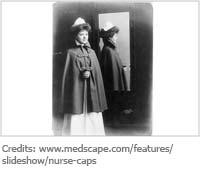
In this photo is a field nurse wearing the modern style cap in 1909. If you would notice, nurses in America did not yield to wearing the traditional nun's veil to keep hair away from their faces, but chose smaller nurses caps to hold their hair in place instead. The photo also showcases a cape, which was conventionally used by nurses during that time. The cape's collar was wide enough to provide the back of the neck warmth.
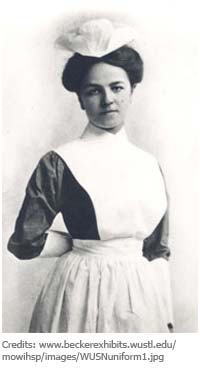
It was in 1910 when the Washington University Training School for Nurses' first nursing uniform was implemented. Back then, a pro and newbie is easily determined just by looking at the nursing uniforms. Students basically wear short-sleeved nursing uniforms, while the senior wear nursing dresses with long hems as well as long colored strips.
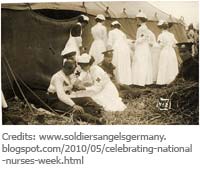
In 1914 when World War I broke, nurses who served were easily identifiable with the Red Cross badge on their nursing uniforms, printed on their brassard, nurse caps and or the chest of their pinafores. Most of the nurses in the photo wear full white nursing uniforms, except for one who probably was a matron or somebody of higher rank. Darker color of uniforms back then was indication of higher rank.
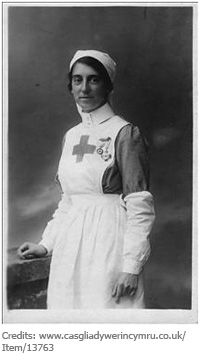
The medals hanging on the chest of the nurse below, and the dark uniform worn under her pinafore are the most noticeable details in this picture. They indicate not only high rank, but also having been able to do significant service for the soldiers during the World War I. Also notice the white cuff that is attached to the sleeves, probably just with garters.

During World War I, in Australia, field nurses wore nursing uniforms that are very similar to nuns' habits, complete with the veil and even called as sisters. Noticeable with their uniforms are the short capes that were largely used in that era by field and travel nurses. Such capes differ in colors and may feature contrast trims depending on the organization or hospital they work with. It is unknown why nurses on such early time already cut the uniforms just below the mid part of calves, but it surely helped them move more freely.

The Australian Army nurse uniform during World War I was closely similar to the ones used by other Australian travel nurses who served in that same era. It was comprised of a long sleeved grey dress that was emblazoned with shiny button closure from the neck to the midriff. A belt was included to secure the dress close to the body. And of course, it also had the cape, a red one, and the nun's veil.
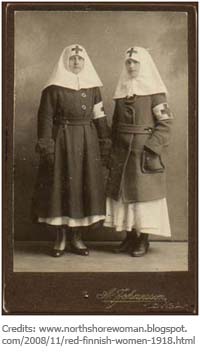
The Red Guard Nurses, on 1918 Finnish Civil War, wore a distinct novitiate nun's headdress that covers the head and forehead, and then flows down to also cover the neck and the shoulders. On their foreheads and brassard were where the Red Cross symbols were placed, easily identifying the wearers as nurses. Due to extreme cold weather in the place, thick coats were usually worn over the white nursing uniforms.
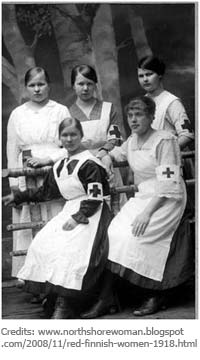
The Red Guard nurses on the following photo wear no nurse veil or cap that would identify them as nurses, only the Red Guard arm band and white apron worn over their dresses. However, it's noticeable that their hairs were pulled in buns. Most probably, though, their veils were removed only during the time the photo was taken, because the period of Finnish Civil War required nurses to wear veils for sanitary purposes.
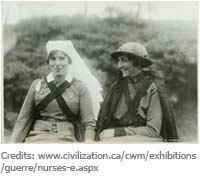
Photographed below are two Canadian nurses in their service dress uniforms in 1918, during the war. Even in those times of unrest, we can already see the sophistication and design balance in military uniforms, including the members of Canadian Army Corps. The uniform that was worn over the clothing accessorized with embroidery to the high neck collar, had the relaxed fit that made it less sleek. On the other hand, the uniform that's emblazoned with glistening buttons was simply given an inner garment with white rolled up collar. Also notice the different head coverings that were used, one wore nun's habit and the other had the usual outdoor cap in the WWI era.
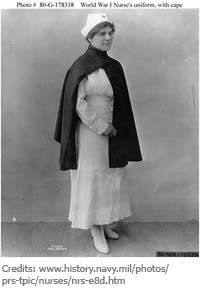
The Red Cross nurses served in the World War I not in battle but for the battlers. Wearing their famous red-lined dark blue cape, with the red lining exposed over the shoulder, these nurses tended for the wounded soldiers. Also making them easily identifiable is the Red Cross insignia on their nurse caps. Worn along with the famous cape, the nurse in the photo worked in long-sleeved nursing uniform top and front buttoned skirt.
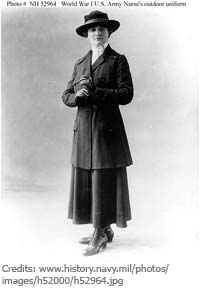
Red Cross nurses during the World War I may enlist in the ANC or Army Nurse Corps, and if wished to go to battle to tend to the members of the U.S. Army, were also seen to have the Red Cross insignia to their service caps. Their outdoor uniforms comprise of long sleeved white top with high neck collar worn over an army coat and a long flared skirt with matching colors. They also usually wear the caduceus, winged staff, and serpents.
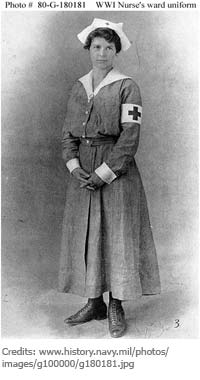
While on duty in the wards, nurses of the Red Cross also wear a specific uniform. The nurse in the photo wore a dress with white wing collar and cuff sleeves. She also wore Red Cross brassard, cap insignia and pin. Shoes wear easily recognizable as part of outdoor nursing uniform. This then suggests that the kind of ward that this nurse served could be in makeshift tent hospitals anywhere near the battlefields, or indicates that they would go out in the field as needed.
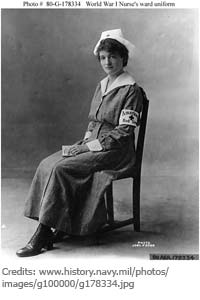
American nurses in France wore similar uniforms as those in the U.S. during the World War. They wore the same grey cotton crepe-made uniforms with double collar/wing collar and cuffed sleeves. They also wore the Red Cross insignia on the cap, pin and brassard, only that the latter bore the words American Red Cross around the insignia for those serving in France.
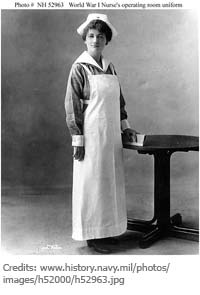
Although the pinafores were a commonplace during the civil war, they faded into the background as years pass by. Protection from stain has mainly become a necessity in the operation rooms and in hospital wards when the situation asked. So, instead of the pinafores that were worn over the nursing dress, utility aprons came in. French laundry problem was one reason why the much smaller aprons were preferred over pinafores.
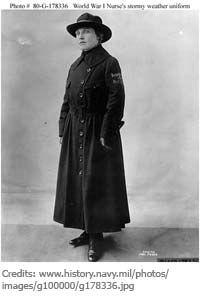
Storms of bullets and bombs that pounded battlefields were unavoidable, so as natural storms. But just as deadly armaments didn't stop nurses from providing medical aid, stormy weathers were won over by them with the help of stormy weather attire. The design of that specific uniform, pictured below, was similar for the Army, Navy and Red Cross nurses. They only differ with the insignia. The insignia at the arm of the nurse in the photo was one that was used by American Red Cross nurses serving under the organization itself.
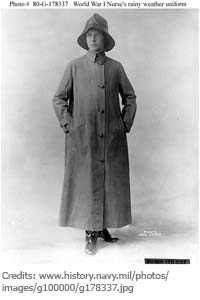
In Europe, wearing rubber boots and southwesters were essentially practical to nurses when the rainy season comes. Without these, doing their duty will be much difficult and riskier. The fitted rolled collar of the southwesters prevented rainwater from drenching their nursing uniforms underneath, while the rubber boots kept their feet dry despite heavy rain and mud.
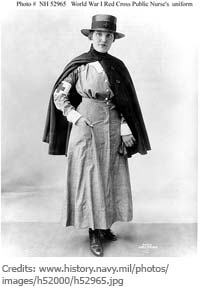
Public health nurse from the Red Cross was to serve in a particular district during the World War I. Significantly, the cape, the regulation hat and the grey cotton crepe nursing uniform proved to be practical. The hat and cape provided protection against scorching heat of the sun and mild rain showers. The grey cotton uniform was comfortable enough and practically much less delicate than whites.
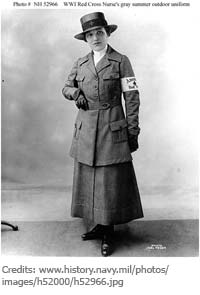
If there's a uniform for the rainy season, there's got to be a uniform for the summer as well. The summer outdoor nursing uniform of American Red Cross nurses during the World War I was comprised of a regulation hat and a white long sleeved inner garment that had high neck collar. Worn over it was a grey coat that had a distinguishably military design, with all the lapel collar and pockets. It also had the distinct brassard of the American Red Cross. For the bottom, a skirt remained appropriate for them. Lighter materials were used to suit the summer season.
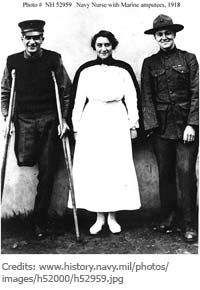
Like the field nurses in 1909, U.S. Navy nurses wore capes that were long enough to cover the entire arms, more than half longer than the capes of Australian travel nurses. But compared with our featured 1909 cape, the following 1918 nurse navy cape had a simpler collar and had closure at the neck. The nursing uniforms still came in all white, except for the cape. Notice that the uniform already had open neck.

The style of U.S. Navy nursing uniforms in 1918 barely changed until the early 1920s. The open neck design of their indoor duty uniform was still present in the 1921 navy nurse uniforms. Compare nursing uniform photos of the nurse at the Naval Hospital in New Orleans with the USS relief nurses. For the time being, they wore a long sleeved button down top with wing collar and skirt that was already given a small patch pocket. The skirt was secured with buttons and the belts were gone.
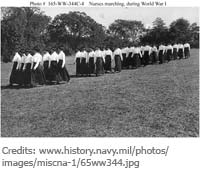
As the skirt emerged in the U.S. Navy, the colored version also came about. Dark colored bottoms were a lot practical to use outdoors. In this photo taken in 1918, the navy nurses were marching with their white tops, colored skirts, as well as dark navy nurse caps, which also come in various styles for different weather conditions.
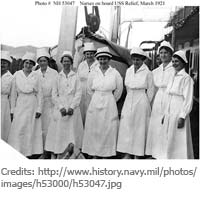
In 1921, U.S. Navy nurses' uniforms were identical, except for the nurse cap. Notice in this photo that the staff members' caps didn't have a stripe on them, while the chief nurse had it. Five years later, though, navy nurse caps were all given the stripes. Depending on the position, a nurse bears several stripes on their caps.
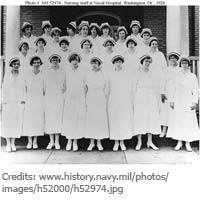
Aside from giving the stripe to the caps of all U.S. Navy nurses, their collars also received notable change. They were a lot smaller, and were given emblems on both sides. This design lasted from 1923 to 1960s. Small details changed as the years pass by, such as the hem going 12 inches from 10 inches above the floor in the late 1920s to early 1930s.
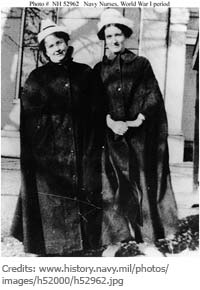
In the cold seasons of 1922, when the soldiers needed immediate medical attention, Navy nurses would go out wearing a full length cape that also served as coat for enough warmth. Capes came in different lengths, and worn depending on the need. In this photo, it is worn with indoor duty uniform.
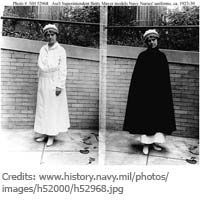
Belt was not back in the 1923-1960 U.S. Navy nurse uniform. The wide belt featured in the following photo was a part of the skirt itself. This time, the belt was secured by two buttons, which run three more buttons down the skirt. For style, the buttoned portion of the skirt was not aligned with the buttons of the top. To its right is a photo featuring another cape, a shorter one, worn over an indoor duty nursing uniform.
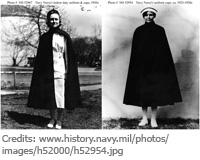
In this photo is a cape worn with indoor duty uniform, but with different nurse caps.

The U.S. Navy nurses have both indoor and outdoor duty uniforms. While those for indoor looked more closely like the typical nursing uniforms, those worn outdoors were a lot different as they look more formal. Navy nurses outdoor uniforms comprised a coat and tie for the top and skirt for the bottom. They come in one design but in two different colors, blue and white, and with matching stockings and shoes.
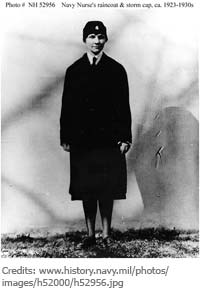
Working outdoors also put U.S. Navy nurses under heavy rains, hence they have another version of nursing uniform designed for rainy days. A navy nurse raincoat, with a storm cap, worn over an outdoor duty uniform is featured in the photo below.
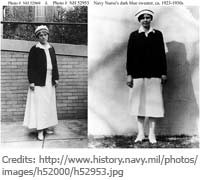
Even before warm-up scrub jackets were introduced to the nurses, the U.S. Navy nurses were already using them. In the following photos are the blue knit sweaters used in1923 to 1930s. They may be worn with buttons closed or not.
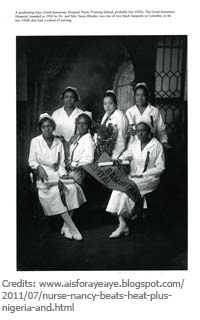
In the following photo were the graduates of Good Samaritan Hospital Nurse Training School, probably in the late 1920s. Graduates wore the symbolic all white nursing uniforms and nurse caps. The design of the uniforms were similar to the U.S. Navy nurses' uniforms in the early 1920s, which were characterized by long sleeved button down top with wing collar and belted skirt. Even the caps also got the stripe similar to that of the U.S. Navy nurses'.
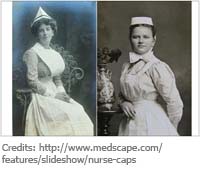
In 1936, 11 years after Florence Nightingale's death, bib, apron and long sleeve cuffs were still standard in the nursing uniforms. But the more elaborate nursing caps gave the nurses a rather glamorous look. Instead of the plain nun's habit veil, nurse caps came out in different styles, with almost every hospital and nursing school designing their own caps to identify their staff and students. Most of these caps were too small that they can no longer hold long hair like the nuns' veil did. In fact, in the latter years of the nursing caps, they were worn simply as symbolic identification and not for sanitary purposes at all. Many times they were worn as mere ornaments.
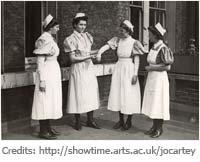
Before long the sleeves of nursing uniform dress received major change. On 1942 in London, the long sleeves, which were also sometimes massive puff sleeves, were cut short. This was largely due to the clothing material shortage during the World War II. Supplies of fabrics were mainly reserved for the army and the war. However, the long sleeves didn't really totally go off because they made use of detachable cuffs as shown in the following image. And as for the massive puff sleeves, they remained in the scene. In the same image, the nursing uniforms were also noticeably shorter than their ancestors.
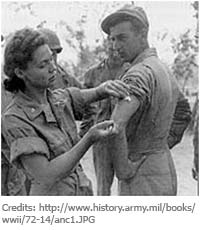
When World War II broke, the nurses of the U.S. Army Nurse Corps were dispersed to different locations around the world where there were battles, just like the American soldiers. Pictured in this photo is an American nurse serving in Queensland, Australia, in 1942. During that time, the materials and colors of women's uniforms were similar as the men's to keep the costs low, regardless of where they were assigned.
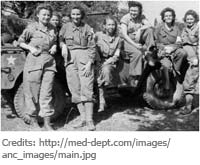
Group of Army Nurses of the 10th Field Hospital, in 1943, wore military-inspired multi-pocketed tops and pants. The 10th Field Hospital served in Tunisia, Sicily, Italy, French Riviera, and in the Moselle area.
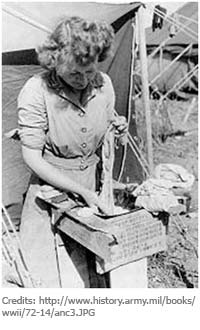
An American nurse serving in Oujda, Morocco, in 1943, wore the blue cotton crepe nursing dress.
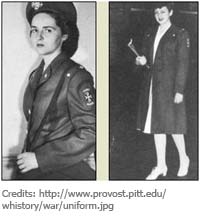
When the University of Pittsburgh was authorized to organize a unit of the United States Cadet Nurse Corps in 1943, a new uniform appeared. It was a gray wool suit or overcoat with regimental red epaulets, silver insignia buttons, a sleeve patch with a silver Maltese Cross on a red ground, and an adaptation of the famous Montgomery beret.
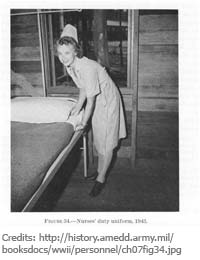
The World War II was an era for salvaging things that still have value and maximizing the available resources. In the U.S., the garment industry was controlled by the federal government, and all others supported such approach and made sacrifices, including the nurses who were also serving the America along side the country's soldiers. This 1943 nurses duty uniform features a cut that was common in most of women's garments in WWI. The hemline falls just below the knee, and the sleeves were much shorter than those of the previous nursing uniforms.
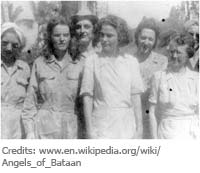
Two nurses in the front left portion in the photo below, who served in the Philippines, wore similar nurses' duty uniform as the nurse in the photo above. That particular uniform was the cotton seersucker, one that may be worn with a jacket or suit. See the beige seersucker in the following photo.
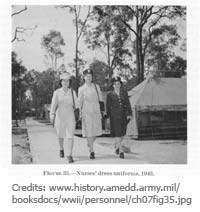
Inside camps where temporary hospitals were erected, army nurses continue to provide patient care to wounded soldiers and civilians of the Second World War. In this photo from 1943, two colors of the army nursing uniforms were worn in different ways, tucked and not tucked, and matched with complementary nurse caps.
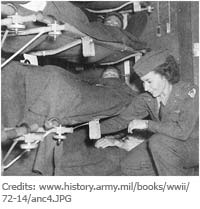
It was during the Second World War II when the work pants were created for women as well. The practically of workwear pants proved to be significant, especially for those who work in the field such as the nurses. In the following 1944 photo is An American army flight nurse in Prestwick, Scotland. She wears a nursing uniform that comprises of suit, pants, and beret.
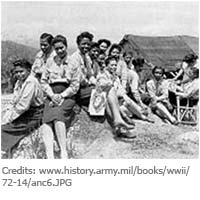
The army nurses also served in several Asian lands, such as Burma, China and India, where they had to work with patients and staff that had a very different culture, a huge obstacle that came in the way of administering care. Pictured below were the staff of Tagap Hospital in Burma, in 1945. They wore long sleeves nursing uniforms with tie, tucked in nurse skirts that fell below the knee.
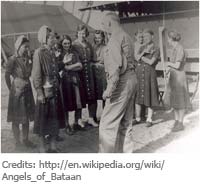
As the World War II approached end, U.S. Navy nurses who fell as prisoners of war during the Japanese occupation in the south eastern Asian country, Philippines, were also liberated. In this picture are the rescued navy nurses, known as the Angels of Bataan, in their long-sleeved, button down blue cotton crepe nursing dress with lapel collar. Others wore the short sleeved version.
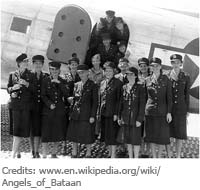
American nurses posed for this photo before leaving the Philippine Archipelago. They wore dark olive-drab elastic wool jacket, skirt nursing uniforms, and matching service caps for officers. Under the suit was a khaki wool shirt. This uniform was used from 1942 to 1951. (The following 2 more photos will show a clearer picture of this Army Nurse Corps officer uniforms and headgear.) One woman standing at the flight of steps with the beret wore the khaki uniform that was made of cotton poplin fabric.
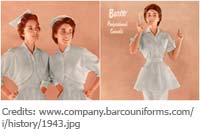
Although, the supply of fabrics was controlled by the federal government during WWI, some companies managed to still create fashionable uniforms for nurses. The following photos feature the 1943 nursing uniforms designed and manufactured by Barco. The company decided to use what was available, the nylon fiber. And since there was shortage of materials during that time, Barco nursing uniforms also adopted the minimal design of the usual nurse uniforms. Wing collar was small, sleeves were short, and boleros were used instead of cardigan.
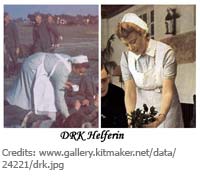
Deutsches Rotes Kreuz (DRK) or German Red Cross nurses basic uniform worn by the DRK helferin | helferinen (helpers) during wartime consisted of medium grey pleated-front blouse or a blue-grey pinstriped blouse and skirt with detachable white collar as shown in the following photos. Worn over the ward dress was the bib-fronted type apron, with hemlines that fell below knee length. The headdress is a starched white nurse cap with a woven band stitched along its front edge, showing a red cross or alternatively the letters RK. They also wore black silk stocking and black lace-up shoes. For the long sleeved blouses, a white armband with Red Cross emblem can be seen surrounded by the German translation of German Red Cross, in black Gothic script.
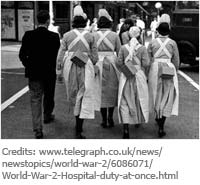
While the nursing uniforms in the United States during the WWII received major changes, those in the United Kingdom barely did. The British nurses still wore the cuffed long sleeved uniforms and aprons with the crisscross design at the back. And with the first aid kit hanging at the back of their waist, they surely proved to always be ready.
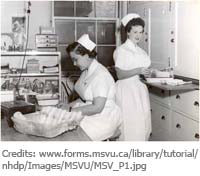
Canada was among the lands that adopted white nursing uniforms from head to toe. The photo, perhaps taken in 1947, shows two nursing students of Mount Saint Vincent University in Halifax, Nova Scotia. They wear short sleeved nursing uniforms, which became largely used in other hospitals around Canada.
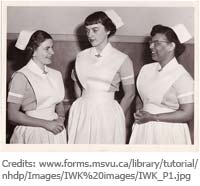
During the Golden Age, the puff sleeves were gone and replaced with simpler ones, with sleeve hems about three inches above the elbows. The usual cuffs, with white trim at their edges, were folded by 2 inches. With other 1950 nursing uniforms, the folds themselves served to be the white contrast trim for the colored nursing dress. Back then, accessories were still restricted, but wristwatches that were necessary for time keeping were allowed.
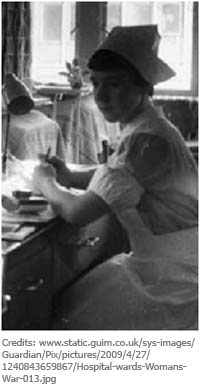
When the sleeves were cut short, it started to also come in many styles besides the fold. The one shown here is a version used in Vale of Leven near Loch Lomond, Scotland, in 1955. Notice puff cuff at the sleeves of the nursing uniform. Besides the length of about 3 inches, the puff cuff looks like it's also detachable. Whether or not it has any practical functions, we can't easily tell, but it surely adds vibe, making it look more different from servant uniforms.
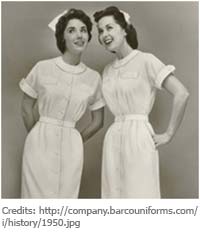
During the 1950s, clothing designers have enough material to create fashionable dresses for women, but a simple design was preferred for nursing uniforms. The image below shows fashion belted button-down nursing dress that's tailored from Dupont's fibers by Barco. A pinafore may also be worn over this nursing uniform.
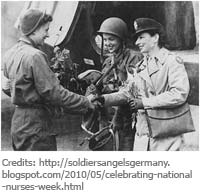
The following photo features a nurse that wears a WAC officer's overcoat that was used in 1942 to 1951. It's an olive-drab wool doeskin cloth. Enlisted ones used the same overcoat style, but without the shoulder tabs and material was of wool serge cloth. The next photo provides a clearer look of this WAC officer's overcoat as well as of the service cap.
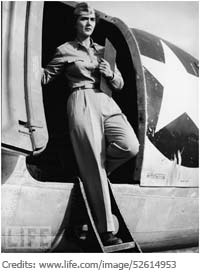
An American flight nurse steps out the U.S. Far East Air Force plane, in 1950, as she arrives in North Korea during the Korean War that ended on 1953. Flight nurses usually wear pants to pair with the military-inspired uniform tops, either for the long-sleeved button down uniform or the one worn with suit. Completing the military look of flight nurses, they also wear berets.

The end of the World War II opened for an enthusiastic clothing industry, even integrating fashion in nursing uniforms. The following art photo showcases four different nursing uniforms of the 1950s, all of which notable of sophisticated style. Each pair of nursing skirt and top features tight waist with belt, button closures, modest neckline, and either long or three-fourth sleeves. Skirts have distinct flair that's complemented with a pair pockets for practical use.
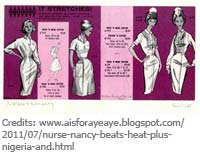
In the 1960s, women dresses began declining in length again. However, this time, war was no longer involved. Shorter dresses started becoming customary, which would advance in shortness down to the new millennium. Modest cut remains a necessity with nursing uniforms, though. Fitted skirts that fell to the knees became popular. Fabric technology also had developments, brining wash and wear cotton as well as Dracon and cotton fabrics mix.

Different companies experimented on different materials for nursing uniforms, in which Barco came up with warp knits. It's a type of fabric that enabled elegant look, comfortable feel, and easy laundry care come in every Barco uniform. In this photo, the belt was starting to disappear, and the neckline gone a little lower. But, the nurse cap remained a staple as you could notice.
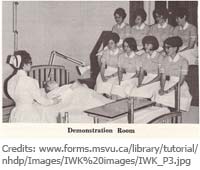
In 1961, when nurses in Nova Scotia were still wearing long sleeved dresses with pinafores, students wore nursing uniforms comprised of short sleeved tops and skirts. In this photo, student nurses already wear nameplates. Also notice the rolled Peter Pan collar as well as the contrast trims to its rolled-up set-in sleeves, they match the skirts.
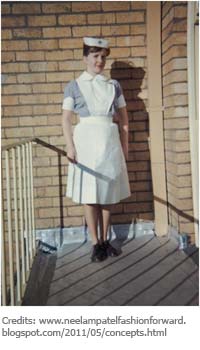
While sleeves were constantly changing, the hem of the nursing uniforms also gets higher. An employee of Prince Harry's Hospital poses in here nursing uniforms in 1962. This particular uniform can now be actually considered as standard uniform in the modern nursing profession. The sleeves were sleek, the shorter apron got patch pocket, and the neckline remained modest with the rounded collar secured by a button.

Although colored nursing uniforms have been in the industry for quite some time already, the white uniforms were still widely used. The following nursing uniform was the hospital duty dress of enlisted women and civil service employees alike in 1962 to 1975. Made from cotton poplin, nurses may wear the white duty nursing dress with black oxfords or optional white oxfords as authorized. They may also wear the uniform with green cardigan sweater, cap, and white stockings.

Uniform pants, which were specially worn in the field, became a thing of the past as pantsuits were authorized also as duty uniforms in medical facilities, in 1978. The said nursing uniform came with a beret, pins and name plate. This pantsuit became controversial when wearing the particular uniform was made optional fro those who want to buy and wear the uniform.
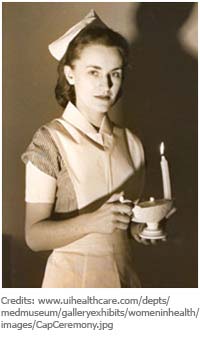
This nursing uniform, used in State University of Iowa School of Nursing, is almost identical to the above version. The only difference was the slimmer collar that's got pointed tips. But as for the sleeves, sleeve cuffs and apron, they were unchanged. The picture was probably taken in the late 1960's or earlier, for in 1971, nurse caps were no longer used in the State University of Iowa School of Nursing.
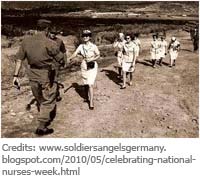
The two-decade long Vietnam War surely needed all the medical aid they can get as the war advances and many soldiers got wounded, losing limbs, and dying in battle. Some of dedicated nurses who have the heart to aid the servicemen during the mayhem are featured in the photo. Probably taken in 1970s, in Da Nang, Vietnam, the American nurses wore shorter fitted skirts, with hemlines just above the knee.
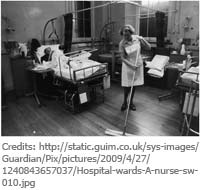
In 1979, bibs, which usually go with the apron as pinafore, were stripped of straps. Bibs were simply attached to the top section of the dress by using some pins. In the photo below, notice that the hem of the nursing uniform simply fell below the knees. Are we seeing dress-shirt button down collar here? And where is the cap? Photo taken at St .Mary's Hospital, Paddington, London.
























































































